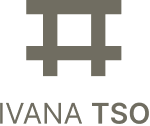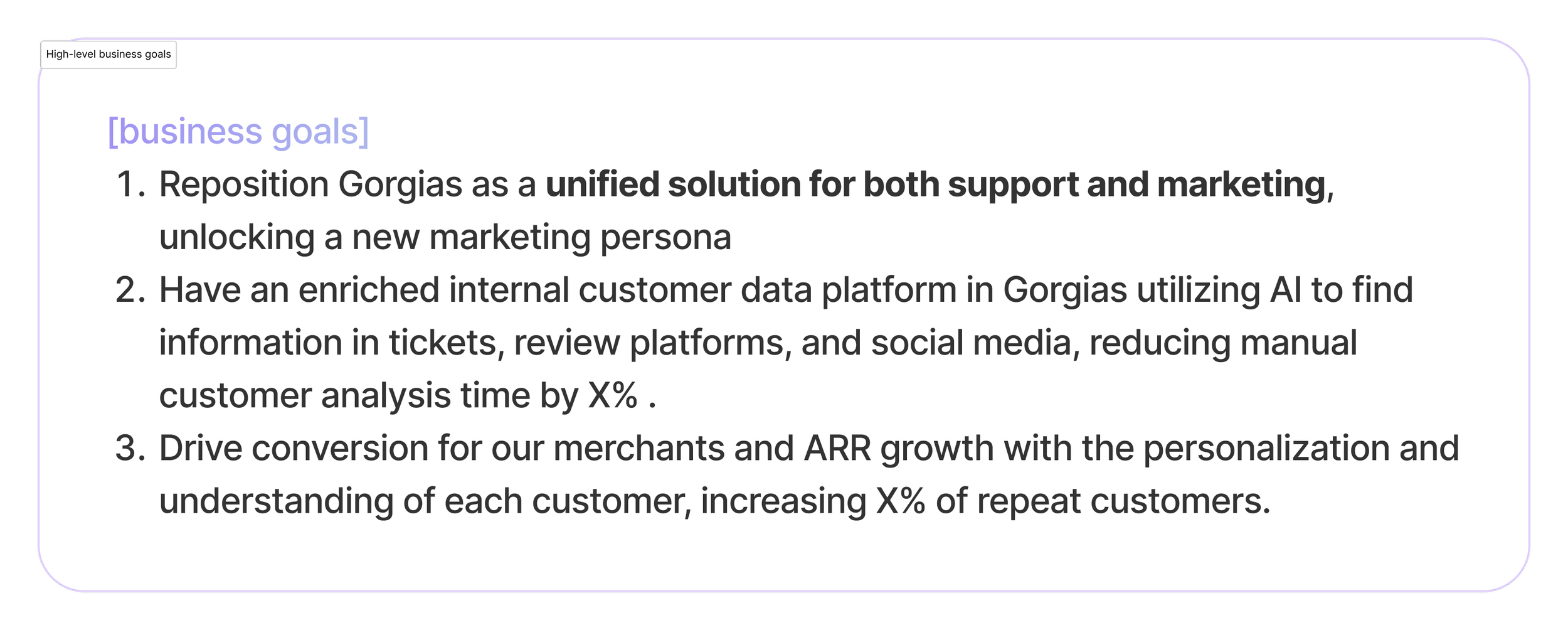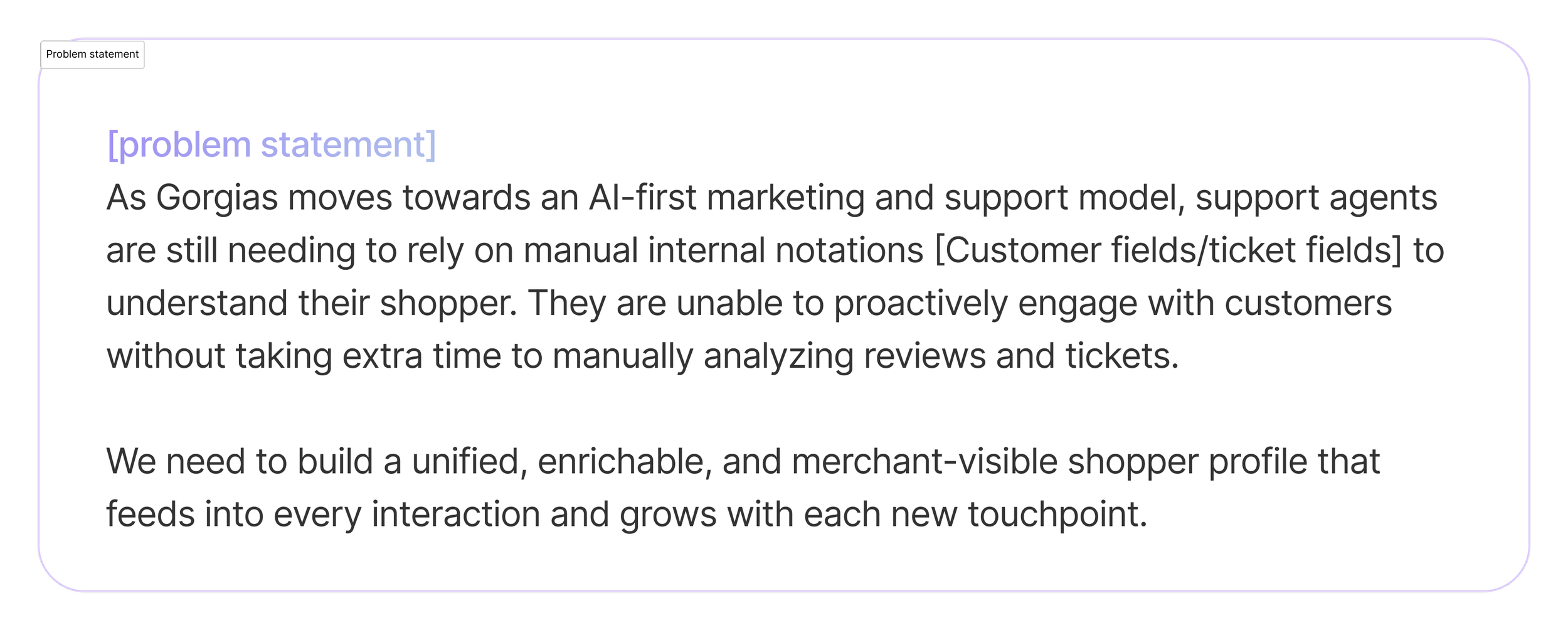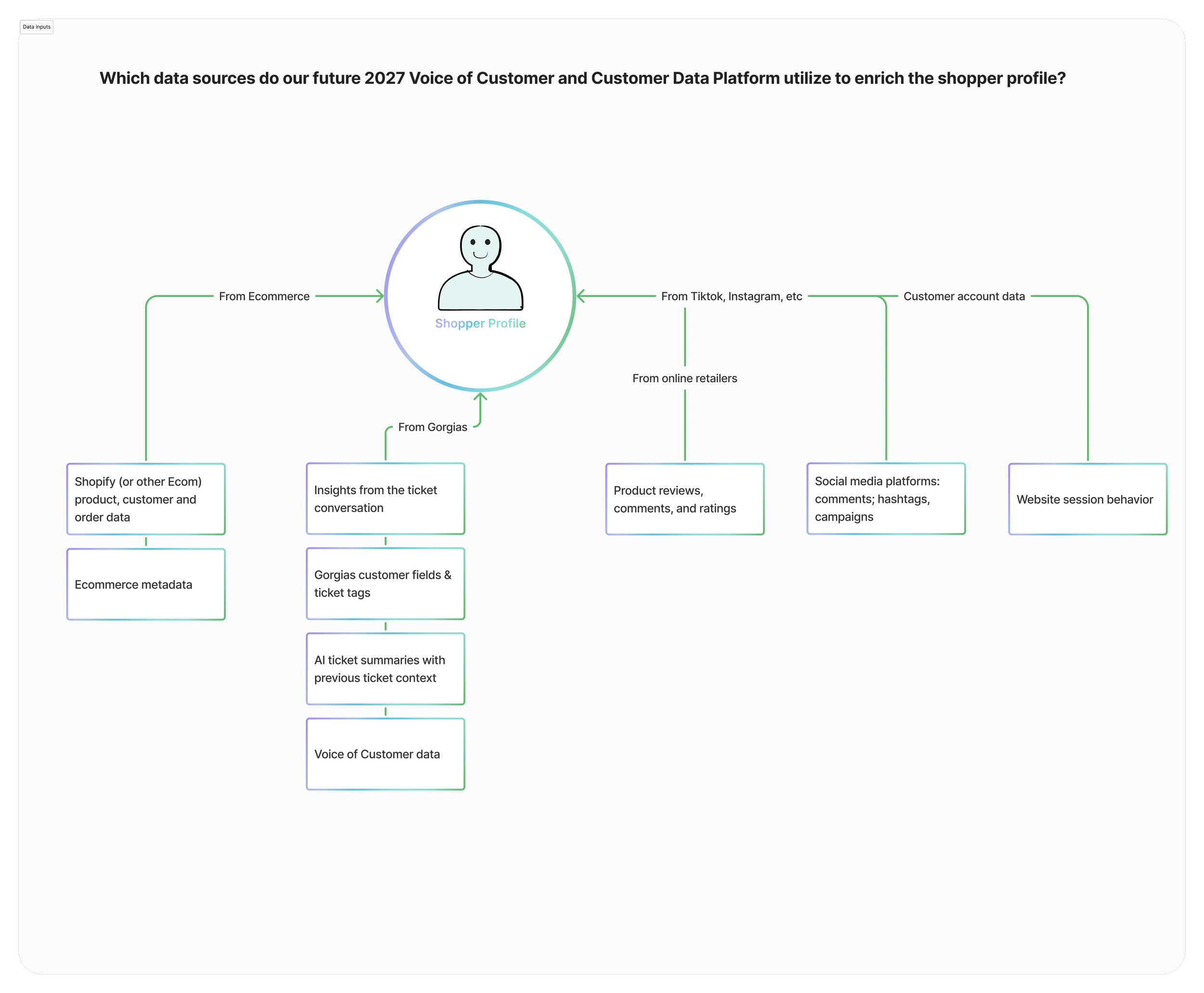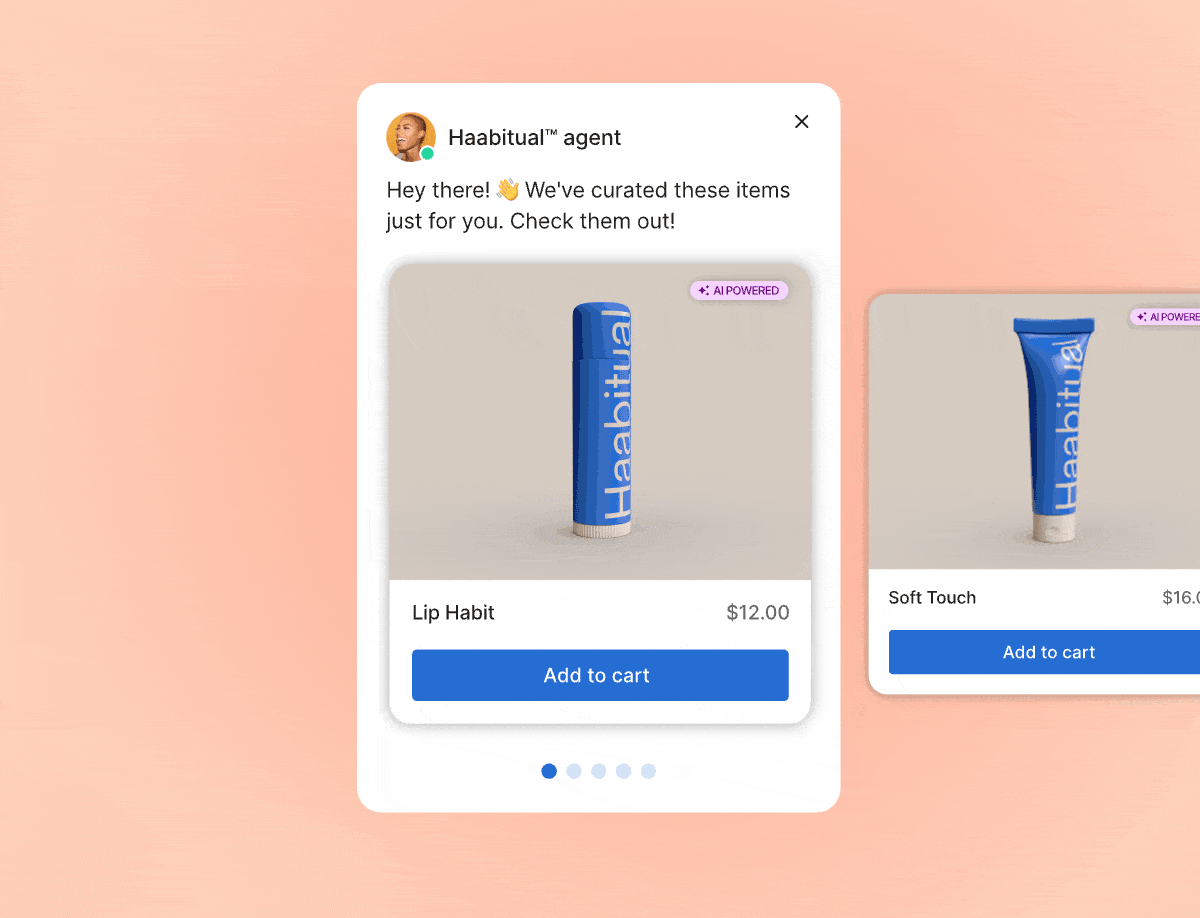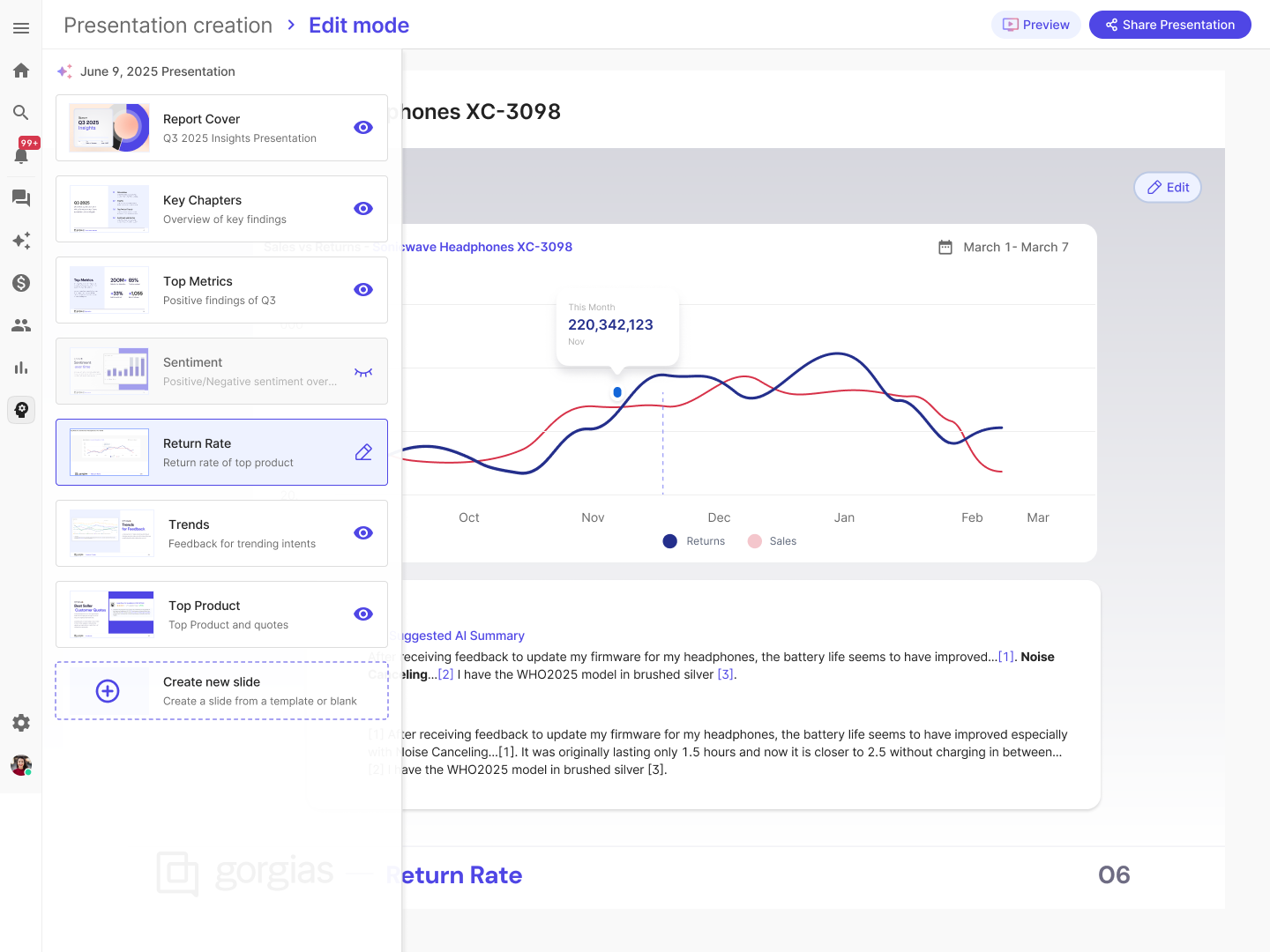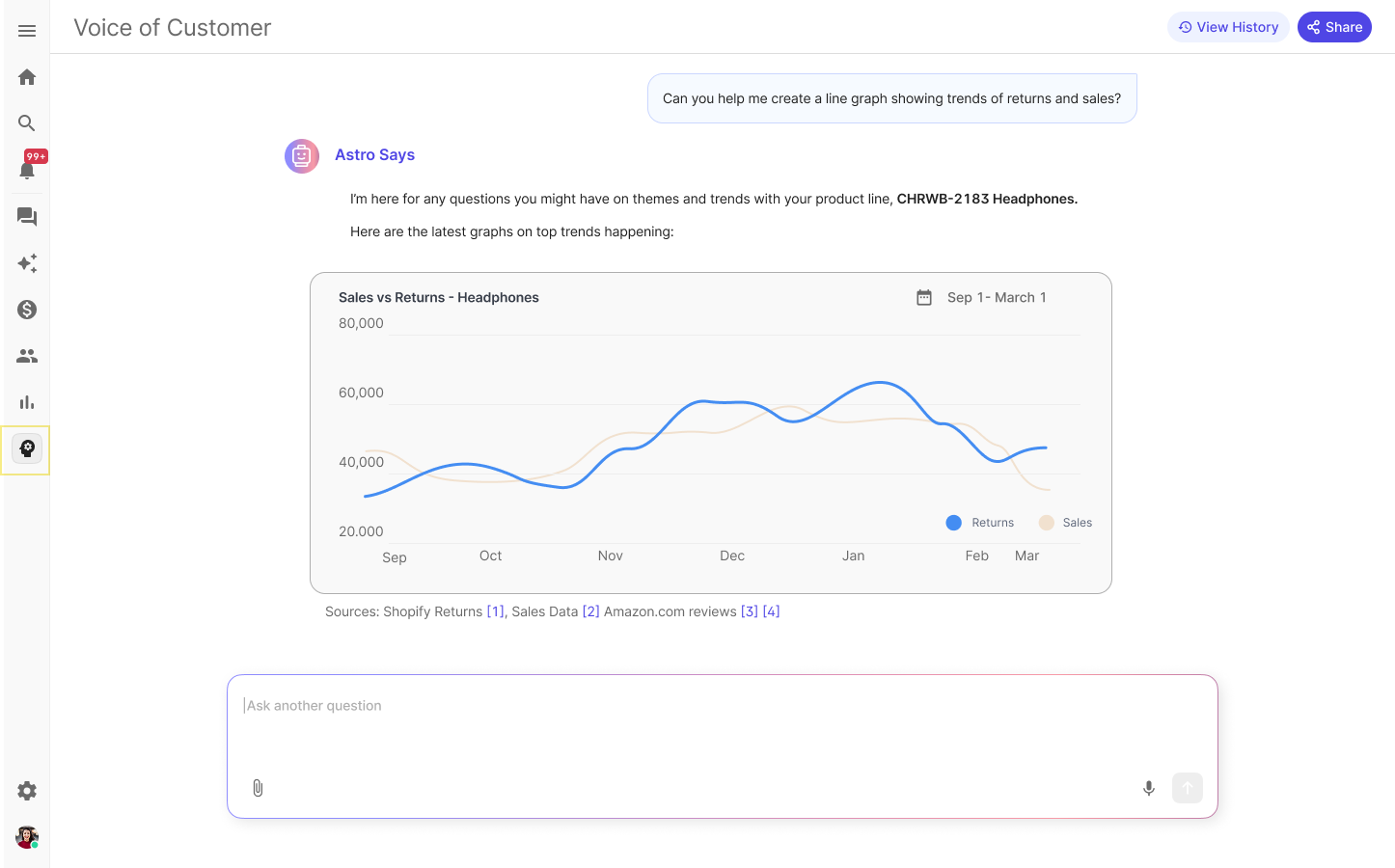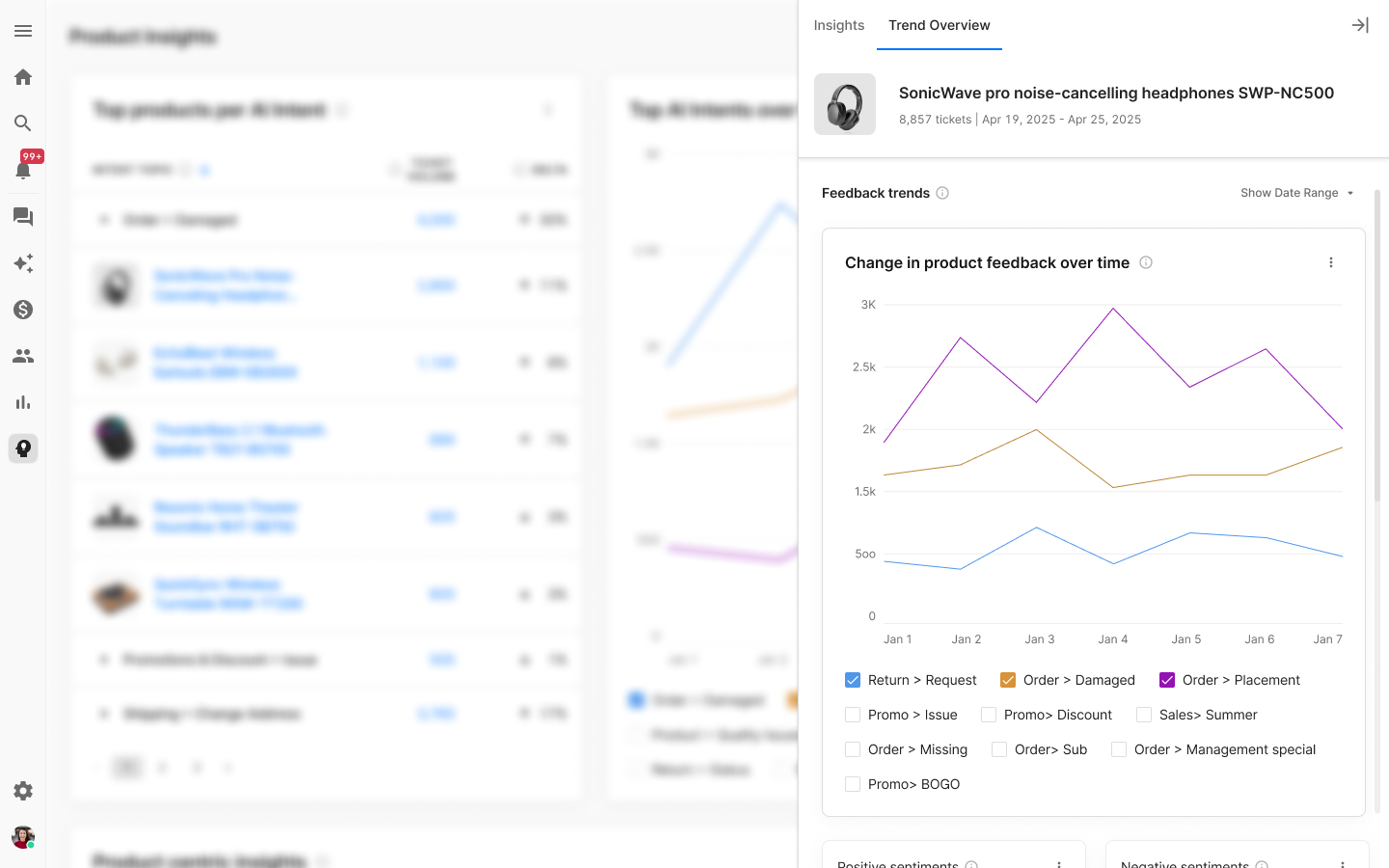
Voice of Customer Data
Building AI-powered customer insights platform from ideation to launch.
About Voice of Customer for Gorgias
Gorgias combines conversational AI with sales and support skills, allowing e-commerce brands to personalize interactions with their customer base.
While conducting user interviews to surface key frustrations of our enterprise customers, we discovered a potential gap that could help our customer experience (CX) teams and their cross-functional partners extract actionable insights.
We understood that Gorgias tickets gave the ability to aggregate help desk tickets, and allow a deep-dive into precious data, but the current methods were very manual and reactive. How might we slash the manual reporting and surface valuable insights to our CX teams?
Team: Product Designer (Self), Product Manager, Engineering Manager, 6 Engineers
Timeline: Q2 2025 (initial design), Q3 2025 (Beta iterations & GA rollout)
Tools: Figma, Notion, User Testing, Product Market Fit Interviews, AI Intent Topics, Shopify
The Problem
Gorgias ticket and customer information provides valuable insights for our CX teams. However, the teams must manually and slowly aggregate the insights to report to cross functional teams. This leads to a reported 8-16 hours of additional workload monthly to review the data and react to major customer concerns.
As CX roles continue to morph in the presence of AI, how might we grow the CX role and help their cross-functional partners (Product, E-commerce, Logistics, Marketing, and Leadership) extract these insights leveraging AI, and shorten the issue detection periods to 1-2 days?
Key Points
😵💫 Time-consuming manual ticket tagging & analysis process
CX managers spend additional 8-16 hours monthly, which is error-prone and laborious. Extracting insight often requires heavy spreadsheet work, pivot tables, and aggregating feedback from hundreds of tickets and reviews.
🔗 Difficult to link actionable insights to key topics
Teams struggle to correlate feedback to the key topic, whether it's product issues, brand perception, logistics delays, or promotion performance.
🐌 Delayed issue detection damage brand and customer satisfaction
Trends (e.g., product defects, logistics delays) are often discovered after the insights are presented to key teams, often about a month after customers have repeatedly raised the issue. By the time a pattern is noticed, customer dissatisfaction may already be widespread, affecting retention and brand reputation.
🗣️ Cross-functional communication struggle
Preparing a comprehensive VoC report for other teams (Product, Marketing, Logistics, Leadership) requires merging data from multiple sources and reconciling different tagging conventions.
⛓️💥 Fragmentation customer feedback across different channels
Feedback is combined from multiple channels (tickets, surveys, review platforms, and social media) with no unified view, and CX Managers must manually compile data from multiple platforms, making it difficult to see overall trends quickly.
“I just had like a really difficult call with our quality team where I was like, hey guys, we are tracking so many quality tickets that we have like a thousand tags. I need to get rid of them. And they’re like, well, if you remove them, how are we gonna see like every single quality issue that comes through?”
The Goal
Design the vision of a scalable, AI-powered Voice of Customer reporting experience by understanding current feedback workflows of our enterprise customers, identifying key insight needs, and aligning use cases across cross-functional teams, and a beta product to launch a product market fit test by the next quarter.
Impact
Business Impact: Product Positioning Shift
- Helping Gorgias move from Helpdesk → Customer Intelligence platform and build out the future Customer Data Platform
- Shifting from a SMB product to a Enterprise product
- Establishing confidence in AI and platform strategy foundation
- Internal Impact of Design vision, persona, and user testing with MVP & vision work combined, and pushing for more cross-functional collaboration and out of siloes.
Validation Methods
- Competitor research: Direct, Market, VoC Specific, CRM Specific
- User Interview phases (Initial; PMF, Beta feedback) & Testing
- Beta Usage Metrics: Tracking 40% adoption during beta (weekly check-ins and data collection) and notating disappointment if access lost
- Usage Tracking: Account performed a core action at least 75% of testing time and still willing to pay after Beta ends
- Retention metrics of Beta participants

Discovery and Analysis
User Interviews & Testing Designs
To dive deeper into our customer needs, we conducted multiple types of interviews: general discovery, MVP design testing, and design vision with product-market fit. Out of these interviews, in tandem with competitive research and syncing across multiple teams to understand our AI capabilities, we were able to narrow down key insights:
Writing out personas and problem statements
Ideation presentation to leadership for feedback
Discovery
Splitting up dependancies into categories of when it may be usable based on roadmap-> OK for MVP, Post MVP, or not feasible
“I gave myself the responsibility to report on customer feedback, it wasn’t asked by my leadership team. It’s been a great way to shine the spotlight on my team and what we can do for the company, as I see our roles slowly changing with the introduction of AI .”
“I manually export all the tickets per month and dump them into a document. I like to take quote snippets to help the company leaders gain empathy with our customers, but this takes so much time out of my day.”
Insight Summary
🏷️ Current VoC reports built by merchants rely on Gorgias Ticket Fields
CX teams often rely on their agents to personally tags or ticket fields to categorize issues that may be happening. However, there is a high risk of error to tagging the right categories the higher the ticket count grows.
⏰ There is a lack of real-time or proactive issue identification due to the manual analysis
Summarizing this feedback involves heavy spreadsheet work and going through hundreds of tickets. Issue detective relies on this very long process, and issue detection is reactive.
🗣️ Increased value with cross-functional communication & insights from CX teams
As critical insights are shared with different teams, the CX team becomes more influential, and could foster a company wide focus on CX and their value.
🚫 Currently, there is fragmentation of data and siloed feedback across multiple teams
If we can bring together all the feedback from diverse channels (tickets, emails, surveys, social media, and review platforms), we can create a unified view and improve the quality of VoC insights.
Reviewing designs and ideation with AI and ML engineering teams to understand feasibility and break down dependancies
“We don’t have a systematic way to analyze feedback- we usually have weekly meetings and rely on agents to raise their issues. I then have to take a few hours weekly to read through tickets and understand the problems myself.”
“We currently have agents tag tickets with problems to look for a trend. However, tagging is not always perfect and mistakes hapen often. We have Trustpilot for feedback collection but again, we manually need to take time to review it. Our leadership is always looking for numbers behind our flagged issues. ”
Customer Quotes

Vision Ideation
Creating a North Star Vision vs MVP
While working out the logistics and capabilities with engineering for MVP, I moved forward with building a north star future vision for 2027 for leadership and teams to understand how this product could impact our users. Leadership at the time of this project had never seen a vision more than 6 months in advance, and this was a great time to trial the impact that design could have in a company. The aim was to define and align the broader business goals and show a clear narrative of decision-making that could happen using Ai- driven data insights.
Creating a 2027 persona, user journey, and problem statements based off our customer interviews, allowed us to garner empathy across teams, and show how we could create a product market fit.
🌟North Star Problem Statement🌟
CX teams and their cross-functional partners struggle to extract timely, accurate, and actionable insights from customer feedback. How might we aggregate available data into one platform (CDP), and allow CX teams to present insightful values as the role of CX members continue to change?
Creating our Product Persona
As the Voice of Customer project lines blurred into other team domains, it became clear that we needed the designers and leadership to align on the envisioned 2027 persona that we were working for, along with the main business goals. This way, each team could work confidently on their part to build towards the future together. The below was proposed to leadership with design members on how the CRM teams would work together, proposing a Voice of Customer, Customer Data Platform, Customer Profile, and Helpdesk Workspace product, symbiotic to each other.
Understanding the Jobs to be Done of the two final personas
Growth Marketing Manger vs Customer Success Lead
As discussions continued, we started mapping out what a Growth Marketing Manager or CX Lead would do in the current year, and what the job might entail in the future. Writing out the jobs to be done and the success metrics, and where the role might fall in the future ideated product of Gorgias was presented to VPs of product and design for feedback.
“💡 Future 2027 CX Managers:
In a world where data analysis is highly automated:
- CX manager’s role shifts from manual analysis to strategic decision making and action-oriented execution.
- Jobs to be done will evolve to focus more on interpreting insights, driving cross-functional action, and influence business decisions instead of data aggregation.”
Our future persona: A CX Manager with a shifted focus
Product homepage- Customizable widgets utilizing AI assistant, trend prediction, conversation topic summarization, and sentiment breakdowns.
Review aggregation- allowing all review data from online retailers, Gorgias, tickets, wholesalers be consolidated into one dashboard of data pinpointing product specific reviews.
Customer data and how it can be visualized when comparing segments and customers to products. Utilizing the review and ticket data, able to build a customer profile for users.
Overview page for a CDP platform integrating voice of customer with customer data
AI-assistant sits on top of helpdesk with suggestions and ability to integrate with Slack for quicker teamwork.
Templated report maker automatically updates data using AI data parameters set by user. User can then tweak and have it shared.
Main voice of customer assistant
AI-assistant is able to create dataviz based off of information given on the chart, quickly downloadable or shared monthly via report maker.
Specific review aggregation from different sources combined
Ideating with Technical Constraints for MVP
While working out the logistics and capabilities with engineering for MVP, I moved forward with building a north star future vision for 2027 for leadership and teams to understand how this product could impact our users. Leadership at the time of this project had never seen a vision more than 6 months in advance, and this was a great time to trial the impact that design could have in a company. The aim was to define and align the broader business goals and show a clear narrative of decision-making that could happen using Ai- driven data insights.
Creating a 2027 persona, user journey, and problem statements based off our customer interviews, allowed us to garner empathy across teams, and show how we could create a product market fit.
“🧐 How might we deliver quick and actionable insights based on data Gorgias is able to store?
👉 What details can using Intents in multiple levels (L1:L2:L3) bring to the user?
🗣️ How can we fit sentiment categories to tickets? ( Menacing, Threatening, Human Agent, Negative, Offensive, Positive, Promoter and Urgent), and sort them into two categories of Positive vs Negative for our users?”
Overview including user flows, components, and actions.
Main Dashboard showing top products, and aggregated feedback summaries.
Annotated Main Page with main interactions for Engineering passoff
Component states for accordion dropdown table showing L1>L2 intents, and the top products appearing under each topic category
Side Panel showing trending insights for specific products during selected date range
Annotations for product side panel showing major intents (L1>L2>L3), delta change, and ability to drill down to tickets
Side Panel showing data-vis line charts for change in product feedback over time.
Annotations for product side panel showing data visualizations

Challenges and Learnings
Challenges and Learning Points
Seeing the power of vision work and how design can be leveraged with teammates and leadership was very rewarding. The team was excited to work on what would come, and understood the user pain points and what we were trying to solve.
MVP was a good first step, and working through the product market fit testing was filled with growing pains. From what originally was pitched as a extra feature turned into the possibility of building out a Tiger Team to test and build vision in the near future.
Although the team started off nervous as not being experts in AI, we were able to learn together and explore the abilities of what is able to be done.
Quantitative Impact: In Progress
Monitoring Trend detection: 8-16 hrs/ mo→ 30-60 min/mo
Town Hall (~350 CX attendees): 51% chose VoC as most excited launch
35 enterprise users contacted for PMF Beta testing (Sharing MVP, Vision, Pricing) → 34 agreed to testing, 1 refusal, 2 data unfit. → 31 believe pricing of 3-6 cents/ticket categorized to be reasonable
Aiming for retention of 40% of accounts (14 accounts) moving into GA with payment to consider successful Beta.
Impacting CRM by helping reduce enterprise churn by 63%
Qualitative Impact: In Progress
Role transformations: Helping move the current CX Lead roles from being reactive support → strategic partners for Marketing, Product, Leadership, Warehouse, Buyers.
Increase the influence & trust of CX teams to cross functional partners
Job satisfaction: Ability to be more strategic work with less of the manual work (reviewing hundreds of tickets/ relying on team to bring up issues).
Empowerment: Shine a spotlight on the CX team and what they can do for a company.
